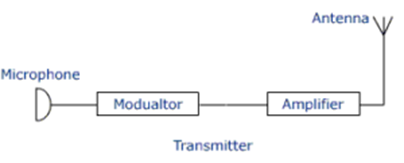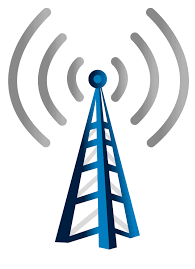Science > Physics > Communication > Communication System
Communication is the process of exchange of information between two entities. It involves sending, receiving and processing information. Thus there is a transmission of information from a source at one place to a receiver located at another place. The communication system is a device or setup used in the transmission of the information from one place to another.
Communication System:
Elements of Communications System:

Primarily communication system consists of three main parts: i) a transmitter ii) a communication channel and iii) a receiver. The transmitter is located at one place, the receiver is located at some other place (far or near) separate from the transmitter, while the channel is the physical medium that connects them. Depending upon the type of communications system, a channel may be in the form of wires or cables connecting the transmitter and the receiver or it may be wireless.
Example: When a person talks with another person directly, then the speaker is the transmitter conveying the information in the form of sound waves through a communication channel, the intervening air and listener is the receiver. If the distance between the speaker and the listener is large sound waves cannot reach from the speaker to the listener directly and communication is not possible. Now to make communication possible we have to change the communication channel and method.
General Working of Communication System:
The devices such as microphones, photodetectors and piezoelectric sensors which convert non-electrical signals into electrical signals are called transducers and vice versa. Microphones convert the sound signals into electrical signals. Photodetectors convert light signals into electrical signals, and piezoelectric sensors convert pressure variations in electrical signals.
The purpose of the transmitter is to convert the message signal produced by the source of information into a form suitable for transmission (generally electric) through the channel. If the output of the information source is a non-electrical signal like a voice signal, a microphone (transducer) is used.
Next step is the modulation. The information signals in the form of electrical signals cannot be transmitted over large distances, so they are superimposed on a high-frequency wave called the carrier wave. This superimposition of the electrical signal on the high-frequency wave (a carrier wave) is called modulation. Thus modulator converts it to transmittable form.
Then the signal is amplified and fed as an input to the transmitter. Which is projected through communication channels using the antenna.

Then this signal propagates through the communication channel. Wires, cables, optical fibres or earth’s atmosphere are used as a communication channel. When a transmitted signal propagates along the channel there is a possibility that the signal may get distorted due to channel imperfection, noise, etc. Thus the receiver receives a corrupted or low powered version of the transmitted signal.
The receiver has the task of operating on the received signal. Antenna retrieves the signal from a communication channel. At the receiver end, the signal is converted back into a recognizable form which can be interpreted by the receiver. The demodulator separates the low-frequency audio signal from the modulated signal. The audio amplifier boosts up the signal to compensate for the loss of power due to attenuation. the amplified signal is fed to a transducer (loudspeaker) which converts the electrical signals into audio signals.

Types of Communication System:
- Point-to-Point Communication: In this mode, communication takes place over a link between a single transmitter and a receiver. Example: Telephony.
- Broadcast Communication: In this mode, there are a large number of receivers corresponding to a single transmitter. Example: radio and television broadcast
Undesirable Effects on Signal During Transmission:
Attenuation:
The loss of strength of a signal while propagating through the communication channel is known as attenuation. Though there are losses at the transmitter end and at the receiver end still it is standard practice to assume transmitter and receiver as ideal. The losses due to attenuation can be compensated with amplification. Hence it is not a serious problem.

Distortion:
It is a waveform perturbation caused by the imperfect response of the system to the desired signal itself. Distortion disappears when the signal causing distortion is turned off or disappears. If the channel has a linear but distorting response, then distortion may be corrected or at least reduced using filter devices called equalizers.

Interference:
Interference is contamination due to extraneous signals from other transmitters, machinery, power lines, switching circuits, and human sources. It is mainly at the receiver end due to intercepting several signals at the same time by the antenna at the receiver end. Proper filtering circuits remove the interference by making the interfering signals to occupy different frequency band than the desired signal.

Noise:
Noise refers to the unwanted signals that tend to disturb the transmission and processing of message signals in a communication system. These are random and unpredictable electrical signals produced by natural processes. The noise may be internal or external. When such random variations in the electrical signal are superimposed on the information-bearing symbol it gets partially or fully corrupted. Using filters noise can be reduced but cannot be eliminated completely.

Antenna:
An antenna or aerial is a system of elevated conductors which couples the transmitter or receiver to the communication channel. Thus it is required at both ends i.e. transmitter end and receiver end. At the transmitter end, the antenna converts electrical signals into electromagnetic waves while at the receiver end the antenna converts electromagnetic waves into electrical signals.
A vertically held transmitting antenna produces vertically polarized electromagnetic waves. The design of an antenna mainly depends on the frequency of the carrier wave and the directivity of the beam.
Types of Antenna:
Hertz Antenna: It is a straight conductor antenna whose length is equal to the half of the wavelength of the radio signals to be transmitted or received.
Marconi Antenna:
It is a straight conductor antenna whose length is equal to the quarter of the wavelength of the radio signals to be transmitted or received. The lower end of the Marconi antenna is grounded.

Doublet or Bipolar Antenna:
It is a bilobed (Two rounded structures) conductor antenna whose length is equal to the half of the wavelength of the radio signals to be transmitted or received. The Number of lobes can be increased to obtain longer antenna.

Omnidirectional Dipole Antenna:
It is used for transmission of radio waves

Dish Type Antenna:
Dish antenna is a directional antenna because it can receive only those waves which are directed towards it and send waves in a particular direction only. The main component of this antenna is dipole or horn feed. In the receiver form, the dish which is in a shape of parabolic reflector collects waves directed towards it and focusses them on the horn feed. In horn feed the electromagnetic waves are converted into electrical signals and are then fed to the amplifier using cables. In the transmission mode, the electrical signals are converted into electromagnetic waves in horn feed and projected on the dish reflector. From reflector, waves are transmitted in the form of a parallel beam.

Size of Antenna or Aerial:
An antenna or aerial is a system of elevated conductors which couples the transmitter or receiver to the communication channel. Thus it is required at both ends i.e. transmitter end and receiver end. At a transmitter end, it converts electrical signals into electromagnetic waves, while at a receiver end it converts electromagnetic waves into electrical signals.
For the efficient transmission and reception, the length of the antenna or aerial is such that it acts as a resonant circuit at the frequency of operation. If λ is a wavelength of the RF signal employed, then the length of the antenna is generally λ/4. As the wavelength is inversely proportional to the wavelength, the length of the antenna decreases with the increase in the carrier wave frequency.
Example- 1:
Calculate the required length of dipole antennas for following carrier waves
40 MHz
c = νλ
∴ λ = c/ν = 3 x 108 / 40 x 106 = 7.5 m
Length of antenna = λ / 4 = 7.5/4 = 1.875 m
400 MHz
c = νλ
∴ λ = c/ν = 3 x 108 / 400 x 106 = 0.75 m
Length of antenna = λ / 4 = 0.75/4 = 0.1875 m
Next Topic: Terminology of Communication System
